FTC Disclosure: Delicious Obsessions may receive comissions from purchases made through links in this article. As an Amazon Associate I earn from qualifying purchases.Read our full terms and conditions here.
Butter.
Does it get any better than butter?
I think not. And I’m pretty sure other people agree with me, based on the comments I received on a recent Facebook post where I stated that “sourdough bread is simply a vessel to carry big globs of grass-fed butter to my mouth.”
So, now that we have all agreed that butter (and by butter, I mean grass-fed butter) is awesome, I have to ask. Have you ever made your own butter? If not, why? It’s so easy and there really is no reason not to make it at least once in your life. There is something so satisfying and soothing about making butter. Maybe it’s because it takes us back to a simpler time when life wasn’t so hectic, before computers, and Facebook, and blogs (oh my!). Or, maybe it’s just the satisfaction of making something on your own that you would normally buy at the store.
I don’t make homemade butter often, mainly because I don’t have access to good quality cream that does not cost an arm and a leg. I typically buy KerryGold, which is grass-fed and excellent in taste. When compared with regular butter, even organic butter, grass-fed is so far superior, it’s hard to describe!
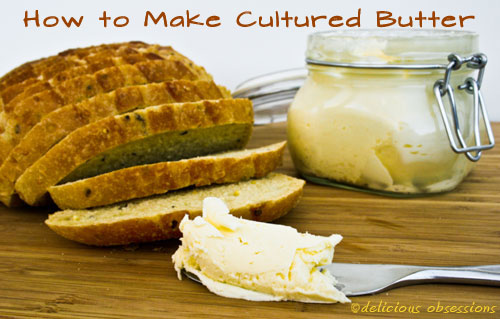
Cultured vs. Sweet Cream Butter
Now, cultured butter is a whole different animal when compared to sweet cream butter. I love both equally. Sweet cream is delicate, rich, and sweet. Cultured butter, on the other hand, is tart and tangy, giving that piece of bread a little extra zip in the mornings. Cultured butter is much more popular in Europe than it is here in the States. The only brand that I know of that makes
Sweet cream is delicate, rich, and sweet. It is what your taste buds are most familiar with when you think of butter.
Cultured butter, on the other hand, is tart and tangy, giving that piece of bread a little extra zip in the mornings. Cultured butter is much more popular in Europe than it is here in the States. The only brand that I know of that makes cultured European-style butter is Organic Valley. Some specialty shops and local health food stores will sometimes sell cultured butter, but it’s definitely harder to find, so that’s why we usually have to resort to making our own.
Don’t get intimidated! Making your own at home is so easy. It only takes two ingredients and a little bit of time. So, let’s get started, shall we?
How to Make European Style Cultured Butter
makes approx. 1 pound
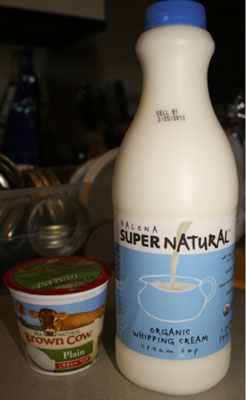
1 quart of high-quality organic cream (raw is best if you’re lucky enough to have access, but anything except ultra-pasteurized is fine)
1 6oz cup of plain, whole milk yogurt with live cultures
Since I don’t have access to fresh, raw cream, I use cream from Kalona Organics. It’s grass-fed and VAT-pasteurized, and it’s the highest quality I can find here in Denver. If you have raw cream … sigh … well, you’re just plain lucky and I want to come over for dinner 😉
In a very, very clean glass bowl or jar, mix the cream and yogurt together gently (I always sanitize my bowl in boiling water whenever I’m starting a new ferment or culture). You want to make sure you’re gentle when you’re whisking the yogurt and cream together because you don’t want the cream to start whipping. Cover tightly with plastic wrap or a sterile lid and let sit out a room temperature overnight or up to 2 days, depending on your house’s temperature. The warmer it is, the faster it will culture. Mine took around 24 hours. If you want a more tart butter, you can leave it longer.
You will know when the cream is ready to make butter when you shake the bowl or jar and it appears thick and doesn’t slosh around. This means the bacteria have been active in working their magic. It should be like a thick kefir consistency. It’s hard to see in the photo below, but when I tilted the bowl to the side, the cream stayed around the edges because it was so thick.
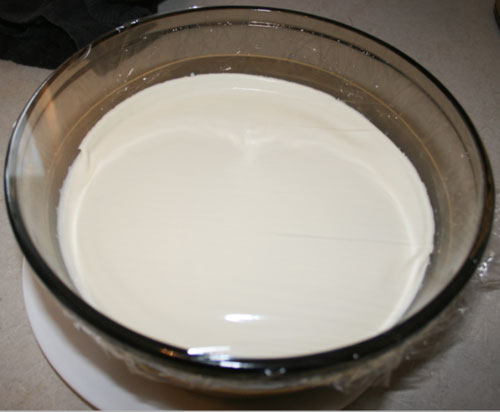
Once your cream is ready to go, you’ll need to gather a couple tools:
- A stand mixer (and its bowl) or a hand mixer with a large, clean bowl
- The whisk attachment for your mixer
- A spatula
- A clean jar or glass for your buttermilk
- Some plastic wrap or a cover for your mixer
- A strainer (optional)
- Some cheesecloth (optional)
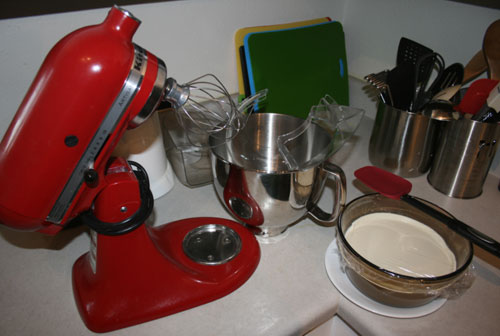
Once you’ve gathered your supplies, you’ll add the cream to your mixing bowl and start to whip it on medium-high speed until soft peaks start to form.
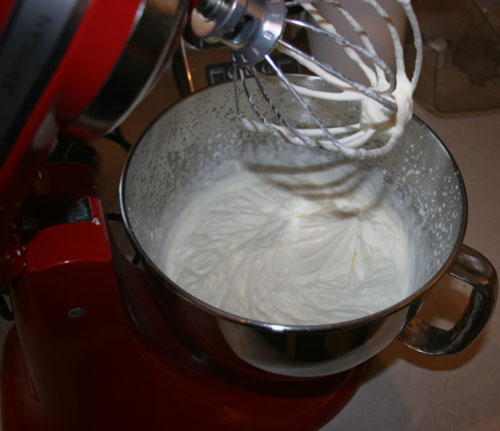
After the soft peaks form, turn down the speed to medium and add your cover. My stand mixer came with a cover that I use, but if you don’t have a cover, I have had good luck tenting some plastic wrap over the mixer and bowl. If you’re using a hand mixer, then I’m not sure how you’d do this step, but I’m sure there is a creative way. Or, just make sure you’re wearing an apron and charge on! 🙂
Before too long, you’ll notice that the cream will start to look a little like crumbled cheese. This happens just as it pushes past the whipped cream stage and right before it separates out into butter and buttermilk. Turn your mixer down to medium-low.
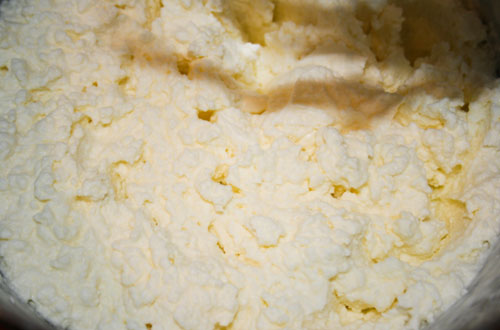
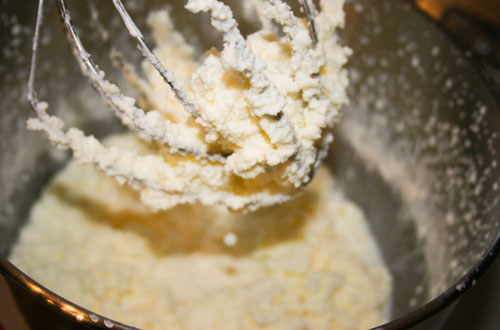
Because this next phase happens quickly, make sure you did indeed turn your mixer on medium-low, otherwise, you will end up covered in buttermilk as it sloshes out of the bowl (some will probably still slosh out, even on the lower speed). Keep the mixer on medium-low speed and the butter will completely separate from the buttermilk. This will probably happen only a few seconds after it reaches the cheese-like stage above.
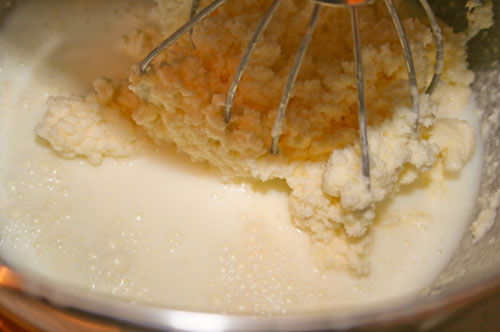
When you reach this point, turn off the mixer and pour off the buttermilk. You can use the strainer for this if you’d like, or just use your spatula to hold the butter back as your pour. You can save the buttermilk for baking, making buttermilk fried chicken (boy, that sounds good), or, if you’re like me, you can just chill it and drink it. YUM!
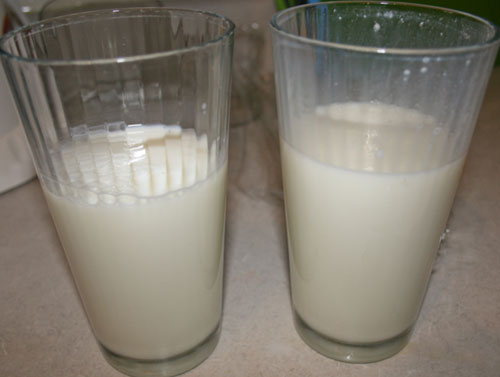
And now, you have butter! Isn’t it gorgeous? This batch is not nearly as yellow as other times that I have made it, because it’s the middle of February and most cows aren’t out on lush, green grass right now. Make this again in the spring and summer, and the color will be quite vibrant!
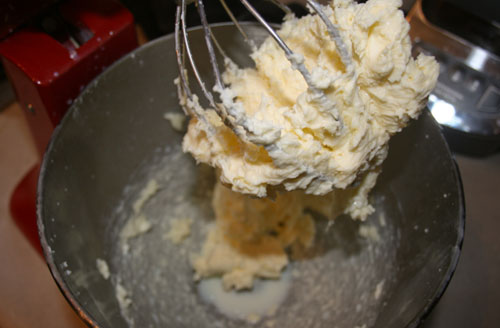
Once you pour off the buttermilk, it’s time to wash the butter. Washing the butter will ensure all of the buttermilk is out and will help extend its shelf life. Though, if you’re like me, homemade butter won’t last long enough to go bad!
To wash the butter, add some cold, filtered water to the butter in your mixing bowl (I use about 3 cups of water at a time), and mix at low speed until the water is clear. You’ll need to do this several times to get clear water. For this batch, it took 4 cycles of washing to get clear water. Just mix for a couple minutes, pour off the water, add more clean water, mix again, pour off the water, etc.
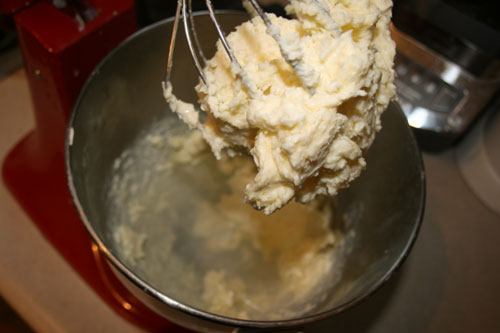
Once the butter has been washed, I like to take my spatula and mush the butter around in the bowl to release more of the water. Then, I pour off any remaining liquid and flavor my butter. You can add fresh herbs, spices, etc. For this batch, I added 1/4 tsp. of pink Himalayan sea salt.
The next step is optional — sometimes I do it and sometimes I don’t. If you really want to make sure all of the water is out of your butter, place it in a clean, fine-mesh tea towel or some cheesecloth and let it hang for a couple hours. This will pull any remaining water out of it. Most of the time, I am lazy and don’t do this step.
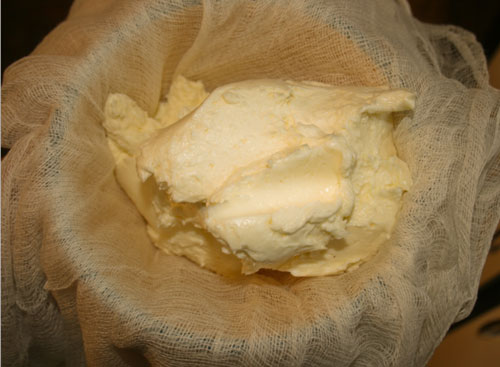
There you have it! You have made butter! Fresh, gorgeous, homemade, cultured butter! Another perfect way to get more probiotics in your system. I am pretty confident that once you make your own butter, you will be hooked. Especially, if you have access to really high-quality cream. The quality of the cream makes all the difference in the end product.
If you want sweet cream butter, just skip adding the yogurt and culturing at room temperature. You can just dump your bottle of cream in the mixer and follow all of the other steps. Super easy, super fast, and super rewarding!
Now, it’s time for breakfast. Let’s go eat some butter! Tell me, have you made butter before? Have you made cultured butter?
For further reading, check out Butter IS Better: The Health Benefits of Grass-Fed Butter and The Saturated Fat Myth: Eat More Butter (and Coconut Oil)!

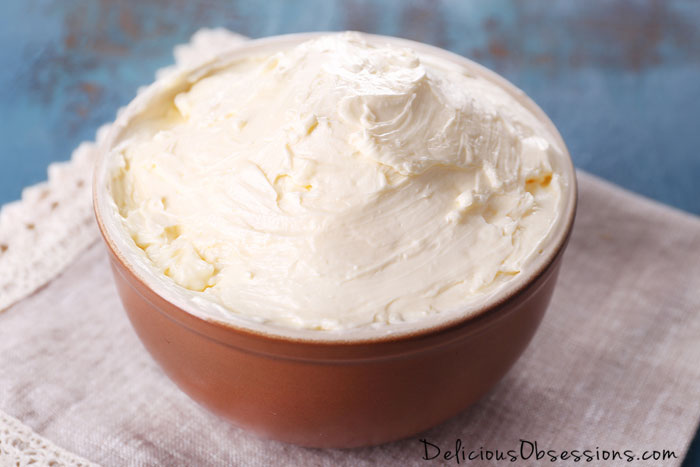
53 Comments